Advanced Financial Accounting: Impairment and Lease Accounting Report
VerifiedAdded on 2020/05/16
|14
|2964
|303
Report
AI Summary
This report provides a comprehensive analysis of advanced financial accounting topics, focusing on impairment testing and lease accounting. Part A examines impairment testing for Forge Group Limited, including objectives, techniques, expenditures, key assumptions, and the absence of opportunistic behavior. It highlights the company's use of goodwill, value-in-use calculations, and the application of AASB 9 standards. Part B delves into lease accounting, comparing current and previous standards. It discusses the obligation to classify leases, the impact on financial statements, the underestimation of liabilities, and the challenges faced by airline companies. The report also addresses criticisms of the new lease accounting standard and its potential impact on leverage and costs. The analysis covers financial reporting practices and the implications for investors and financial statement users.
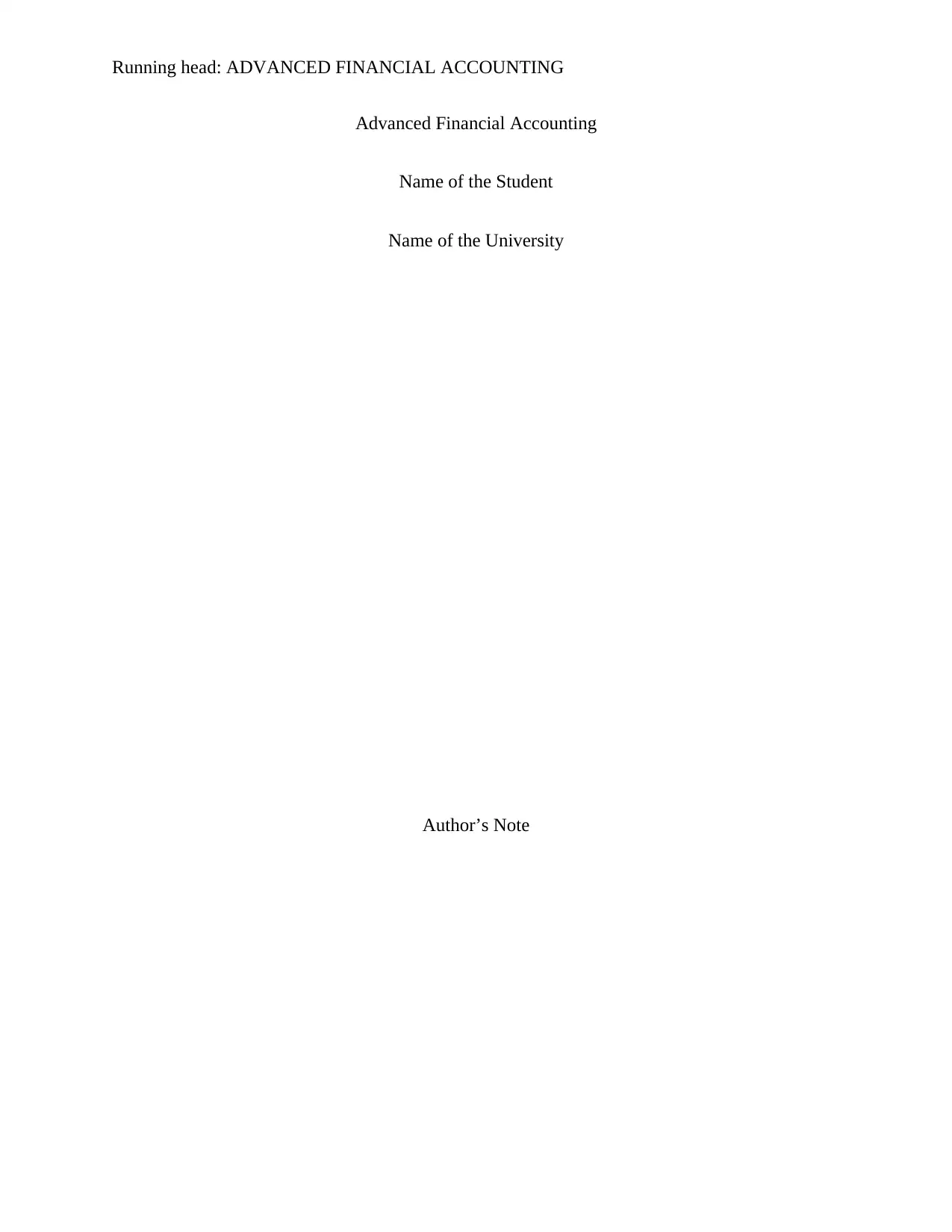
Running head: ADVANCED FINANCIAL ACCOUNTING
Advanced Financial Accounting
Name of the Student
Name of the University
Author’s Note
Advanced Financial Accounting
Name of the Student
Name of the University
Author’s Note
Paraphrase This Document
Need a fresh take? Get an instant paraphrase of this document with our AI Paraphraser
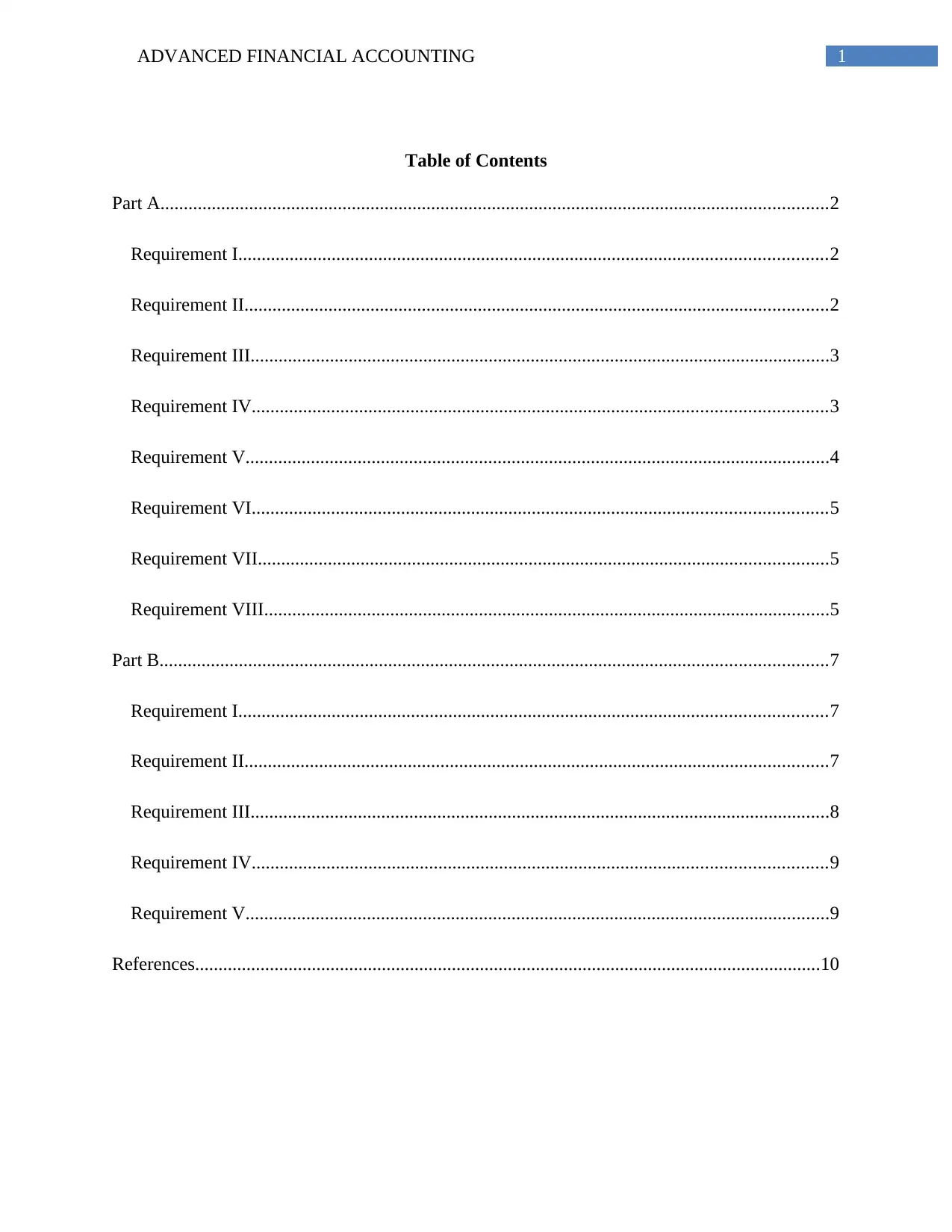
1ADVANCED FINANCIAL ACCOUNTING
Table of Contents
Part A...............................................................................................................................................2
Requirement I..............................................................................................................................2
Requirement II.............................................................................................................................2
Requirement III............................................................................................................................3
Requirement IV...........................................................................................................................3
Requirement V.............................................................................................................................4
Requirement VI...........................................................................................................................5
Requirement VII..........................................................................................................................5
Requirement VIII.........................................................................................................................5
Part B...............................................................................................................................................7
Requirement I..............................................................................................................................7
Requirement II.............................................................................................................................7
Requirement III............................................................................................................................8
Requirement IV...........................................................................................................................9
Requirement V.............................................................................................................................9
References......................................................................................................................................10
Table of Contents
Part A...............................................................................................................................................2
Requirement I..............................................................................................................................2
Requirement II.............................................................................................................................2
Requirement III............................................................................................................................3
Requirement IV...........................................................................................................................3
Requirement V.............................................................................................................................4
Requirement VI...........................................................................................................................5
Requirement VII..........................................................................................................................5
Requirement VIII.........................................................................................................................5
Part B...............................................................................................................................................7
Requirement I..............................................................................................................................7
Requirement II.............................................................................................................................7
Requirement III............................................................................................................................8
Requirement IV...........................................................................................................................9
Requirement V.............................................................................................................................9
References......................................................................................................................................10
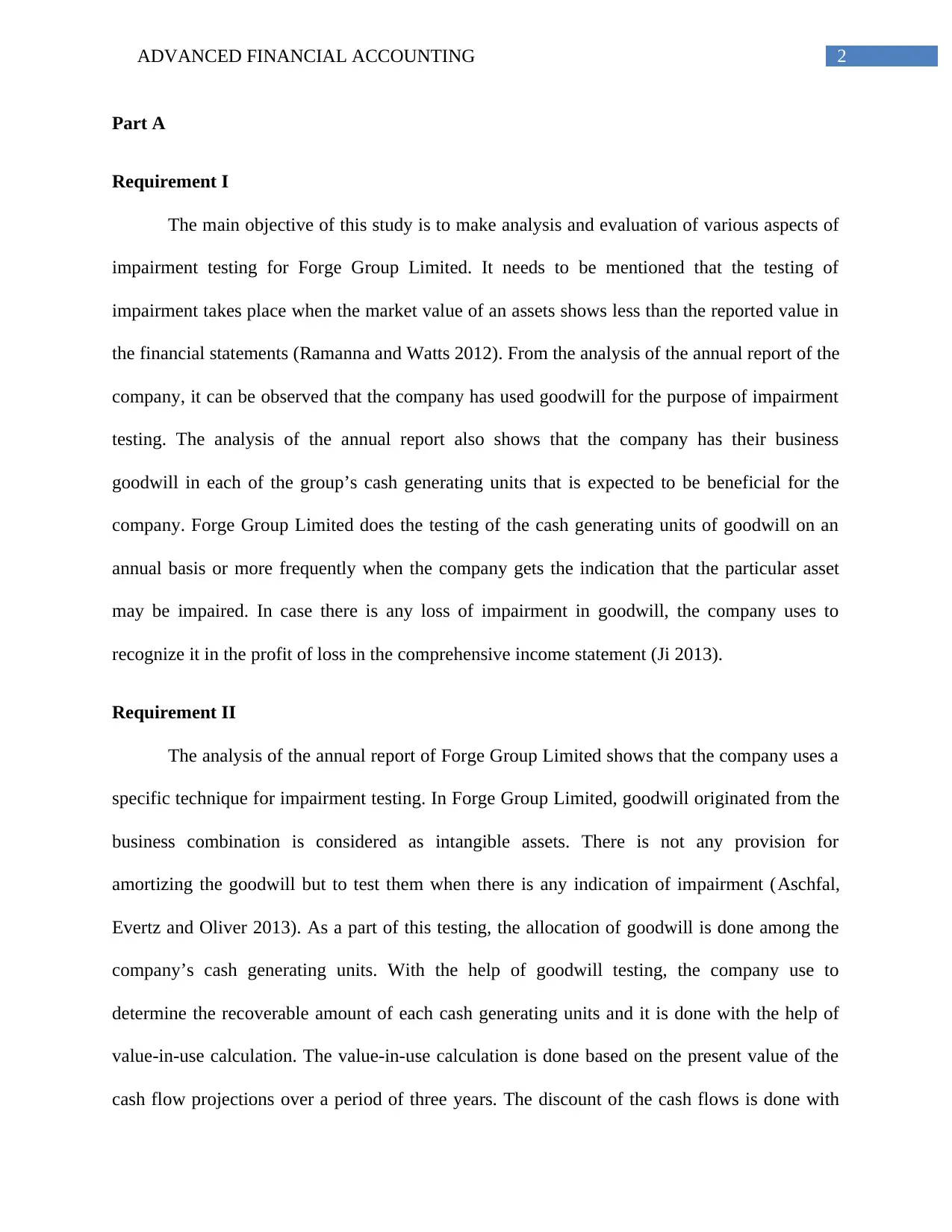
2ADVANCED FINANCIAL ACCOUNTING
Part A
Requirement I
The main objective of this study is to make analysis and evaluation of various aspects of
impairment testing for Forge Group Limited. It needs to be mentioned that the testing of
impairment takes place when the market value of an assets shows less than the reported value in
the financial statements (Ramanna and Watts 2012). From the analysis of the annual report of the
company, it can be observed that the company has used goodwill for the purpose of impairment
testing. The analysis of the annual report also shows that the company has their business
goodwill in each of the group’s cash generating units that is expected to be beneficial for the
company. Forge Group Limited does the testing of the cash generating units of goodwill on an
annual basis or more frequently when the company gets the indication that the particular asset
may be impaired. In case there is any loss of impairment in goodwill, the company uses to
recognize it in the profit of loss in the comprehensive income statement (Ji 2013).
Requirement II
The analysis of the annual report of Forge Group Limited shows that the company uses a
specific technique for impairment testing. In Forge Group Limited, goodwill originated from the
business combination is considered as intangible assets. There is not any provision for
amortizing the goodwill but to test them when there is any indication of impairment (Aschfal,
Evertz and Oliver 2013). As a part of this testing, the allocation of goodwill is done among the
company’s cash generating units. With the help of goodwill testing, the company use to
determine the recoverable amount of each cash generating units and it is done with the help of
value-in-use calculation. The value-in-use calculation is done based on the present value of the
cash flow projections over a period of three years. The discount of the cash flows is done with
Part A
Requirement I
The main objective of this study is to make analysis and evaluation of various aspects of
impairment testing for Forge Group Limited. It needs to be mentioned that the testing of
impairment takes place when the market value of an assets shows less than the reported value in
the financial statements (Ramanna and Watts 2012). From the analysis of the annual report of the
company, it can be observed that the company has used goodwill for the purpose of impairment
testing. The analysis of the annual report also shows that the company has their business
goodwill in each of the group’s cash generating units that is expected to be beneficial for the
company. Forge Group Limited does the testing of the cash generating units of goodwill on an
annual basis or more frequently when the company gets the indication that the particular asset
may be impaired. In case there is any loss of impairment in goodwill, the company uses to
recognize it in the profit of loss in the comprehensive income statement (Ji 2013).
Requirement II
The analysis of the annual report of Forge Group Limited shows that the company uses a
specific technique for impairment testing. In Forge Group Limited, goodwill originated from the
business combination is considered as intangible assets. There is not any provision for
amortizing the goodwill but to test them when there is any indication of impairment (Aschfal,
Evertz and Oliver 2013). As a part of this testing, the allocation of goodwill is done among the
company’s cash generating units. With the help of goodwill testing, the company use to
determine the recoverable amount of each cash generating units and it is done with the help of
value-in-use calculation. The value-in-use calculation is done based on the present value of the
cash flow projections over a period of three years. The discount of the cash flows is done with
⊘ This is a preview!⊘
Do you want full access?
Subscribe today to unlock all pages.

Trusted by 1+ million students worldwide
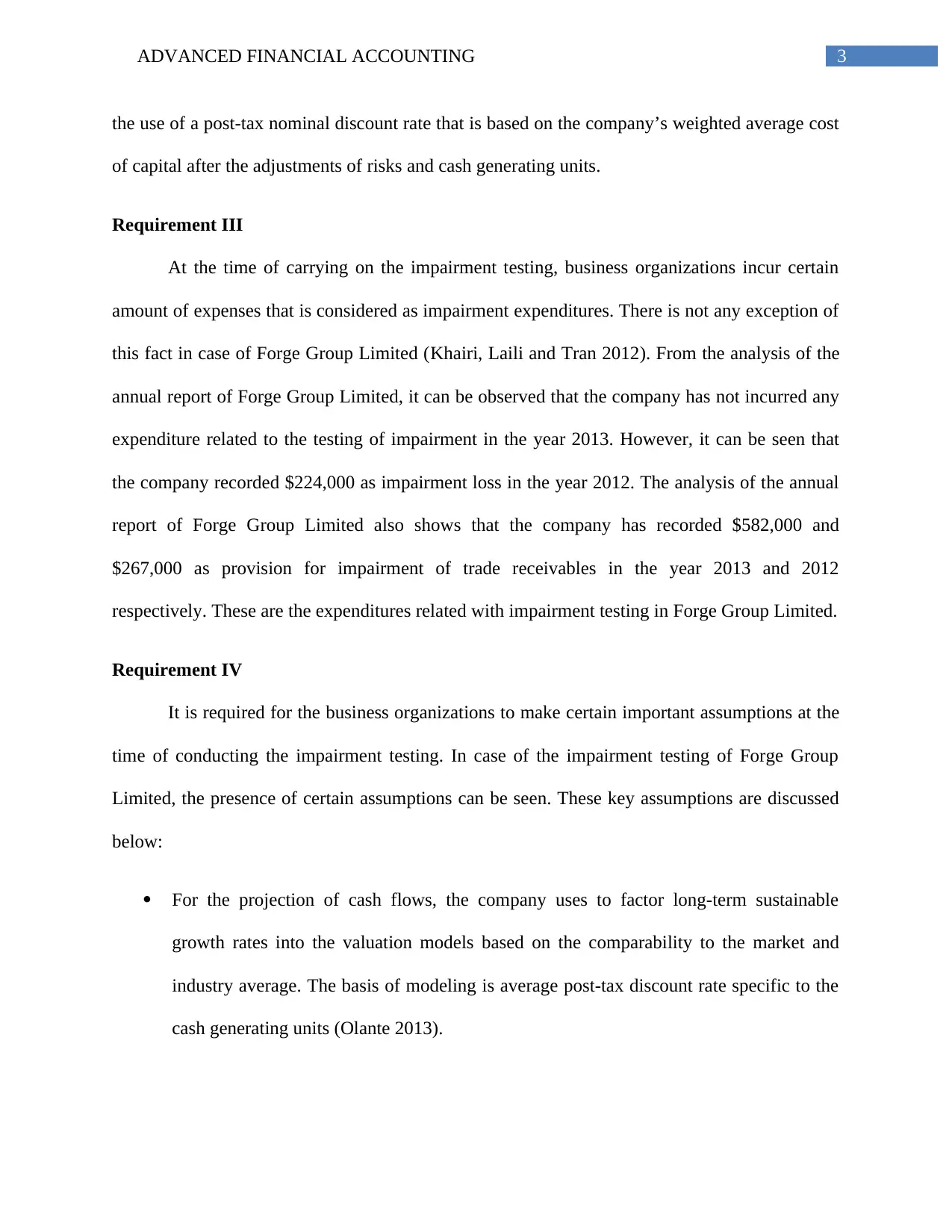
3ADVANCED FINANCIAL ACCOUNTING
the use of a post-tax nominal discount rate that is based on the company’s weighted average cost
of capital after the adjustments of risks and cash generating units.
Requirement III
At the time of carrying on the impairment testing, business organizations incur certain
amount of expenses that is considered as impairment expenditures. There is not any exception of
this fact in case of Forge Group Limited (Khairi, Laili and Tran 2012). From the analysis of the
annual report of Forge Group Limited, it can be observed that the company has not incurred any
expenditure related to the testing of impairment in the year 2013. However, it can be seen that
the company recorded $224,000 as impairment loss in the year 2012. The analysis of the annual
report of Forge Group Limited also shows that the company has recorded $582,000 and
$267,000 as provision for impairment of trade receivables in the year 2013 and 2012
respectively. These are the expenditures related with impairment testing in Forge Group Limited.
Requirement IV
It is required for the business organizations to make certain important assumptions at the
time of conducting the impairment testing. In case of the impairment testing of Forge Group
Limited, the presence of certain assumptions can be seen. These key assumptions are discussed
below:
For the projection of cash flows, the company uses to factor long-term sustainable
growth rates into the valuation models based on the comparability to the market and
industry average. The basis of modeling is average post-tax discount rate specific to the
cash generating units (Olante 2013).
the use of a post-tax nominal discount rate that is based on the company’s weighted average cost
of capital after the adjustments of risks and cash generating units.
Requirement III
At the time of carrying on the impairment testing, business organizations incur certain
amount of expenses that is considered as impairment expenditures. There is not any exception of
this fact in case of Forge Group Limited (Khairi, Laili and Tran 2012). From the analysis of the
annual report of Forge Group Limited, it can be observed that the company has not incurred any
expenditure related to the testing of impairment in the year 2013. However, it can be seen that
the company recorded $224,000 as impairment loss in the year 2012. The analysis of the annual
report of Forge Group Limited also shows that the company has recorded $582,000 and
$267,000 as provision for impairment of trade receivables in the year 2013 and 2012
respectively. These are the expenditures related with impairment testing in Forge Group Limited.
Requirement IV
It is required for the business organizations to make certain important assumptions at the
time of conducting the impairment testing. In case of the impairment testing of Forge Group
Limited, the presence of certain assumptions can be seen. These key assumptions are discussed
below:
For the projection of cash flows, the company uses to factor long-term sustainable
growth rates into the valuation models based on the comparability to the market and
industry average. The basis of modeling is average post-tax discount rate specific to the
cash generating units (Olante 2013).
Paraphrase This Document
Need a fresh take? Get an instant paraphrase of this document with our AI Paraphraser
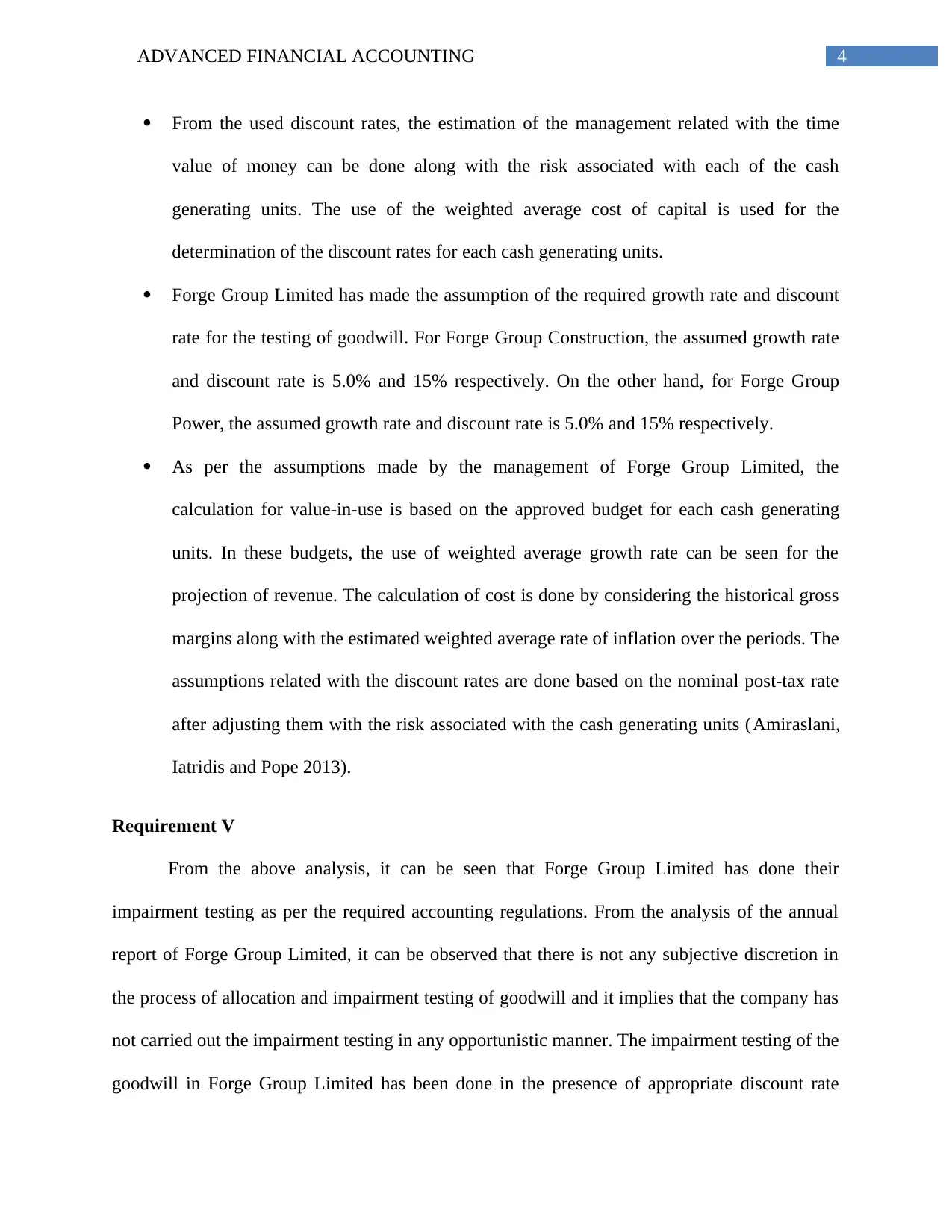
4ADVANCED FINANCIAL ACCOUNTING
From the used discount rates, the estimation of the management related with the time
value of money can be done along with the risk associated with each of the cash
generating units. The use of the weighted average cost of capital is used for the
determination of the discount rates for each cash generating units.
Forge Group Limited has made the assumption of the required growth rate and discount
rate for the testing of goodwill. For Forge Group Construction, the assumed growth rate
and discount rate is 5.0% and 15% respectively. On the other hand, for Forge Group
Power, the assumed growth rate and discount rate is 5.0% and 15% respectively.
As per the assumptions made by the management of Forge Group Limited, the
calculation for value-in-use is based on the approved budget for each cash generating
units. In these budgets, the use of weighted average growth rate can be seen for the
projection of revenue. The calculation of cost is done by considering the historical gross
margins along with the estimated weighted average rate of inflation over the periods. The
assumptions related with the discount rates are done based on the nominal post-tax rate
after adjusting them with the risk associated with the cash generating units (Amiraslani,
Iatridis and Pope 2013).
Requirement V
From the above analysis, it can be seen that Forge Group Limited has done their
impairment testing as per the required accounting regulations. From the analysis of the annual
report of Forge Group Limited, it can be observed that there is not any subjective discretion in
the process of allocation and impairment testing of goodwill and it implies that the company has
not carried out the impairment testing in any opportunistic manner. The impairment testing of the
goodwill in Forge Group Limited has been done in the presence of appropriate discount rate
From the used discount rates, the estimation of the management related with the time
value of money can be done along with the risk associated with each of the cash
generating units. The use of the weighted average cost of capital is used for the
determination of the discount rates for each cash generating units.
Forge Group Limited has made the assumption of the required growth rate and discount
rate for the testing of goodwill. For Forge Group Construction, the assumed growth rate
and discount rate is 5.0% and 15% respectively. On the other hand, for Forge Group
Power, the assumed growth rate and discount rate is 5.0% and 15% respectively.
As per the assumptions made by the management of Forge Group Limited, the
calculation for value-in-use is based on the approved budget for each cash generating
units. In these budgets, the use of weighted average growth rate can be seen for the
projection of revenue. The calculation of cost is done by considering the historical gross
margins along with the estimated weighted average rate of inflation over the periods. The
assumptions related with the discount rates are done based on the nominal post-tax rate
after adjusting them with the risk associated with the cash generating units (Amiraslani,
Iatridis and Pope 2013).
Requirement V
From the above analysis, it can be seen that Forge Group Limited has done their
impairment testing as per the required accounting regulations. From the analysis of the annual
report of Forge Group Limited, it can be observed that there is not any subjective discretion in
the process of allocation and impairment testing of goodwill and it implies that the company has
not carried out the impairment testing in any opportunistic manner. The impairment testing of the
goodwill in Forge Group Limited has been done in the presence of appropriate discount rate
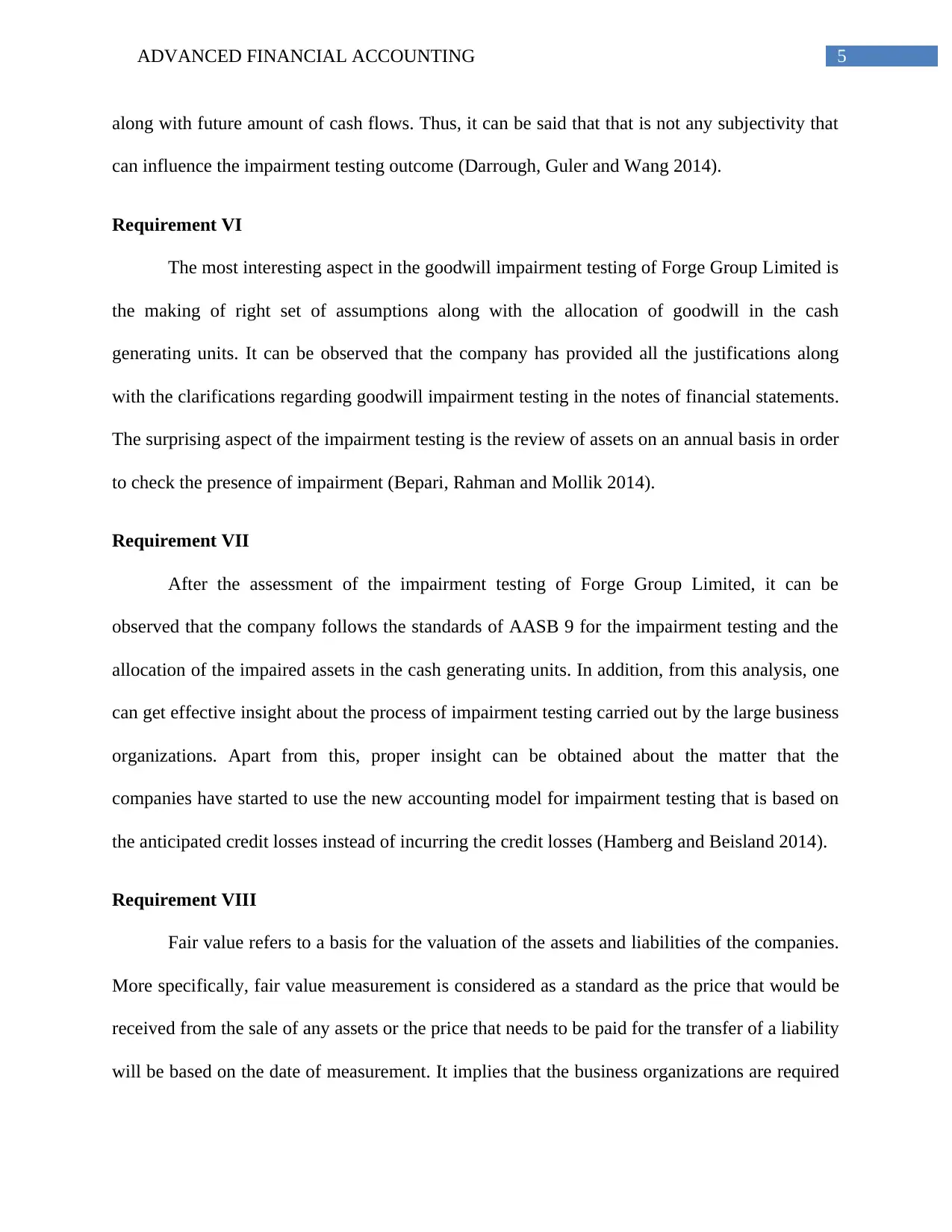
5ADVANCED FINANCIAL ACCOUNTING
along with future amount of cash flows. Thus, it can be said that that is not any subjectivity that
can influence the impairment testing outcome (Darrough, Guler and Wang 2014).
Requirement VI
The most interesting aspect in the goodwill impairment testing of Forge Group Limited is
the making of right set of assumptions along with the allocation of goodwill in the cash
generating units. It can be observed that the company has provided all the justifications along
with the clarifications regarding goodwill impairment testing in the notes of financial statements.
The surprising aspect of the impairment testing is the review of assets on an annual basis in order
to check the presence of impairment (Bepari, Rahman and Mollik 2014).
Requirement VII
After the assessment of the impairment testing of Forge Group Limited, it can be
observed that the company follows the standards of AASB 9 for the impairment testing and the
allocation of the impaired assets in the cash generating units. In addition, from this analysis, one
can get effective insight about the process of impairment testing carried out by the large business
organizations. Apart from this, proper insight can be obtained about the matter that the
companies have started to use the new accounting model for impairment testing that is based on
the anticipated credit losses instead of incurring the credit losses (Hamberg and Beisland 2014).
Requirement VIII
Fair value refers to a basis for the valuation of the assets and liabilities of the companies.
More specifically, fair value measurement is considered as a standard as the price that would be
received from the sale of any assets or the price that needs to be paid for the transfer of a liability
will be based on the date of measurement. It implies that the business organizations are required
along with future amount of cash flows. Thus, it can be said that that is not any subjectivity that
can influence the impairment testing outcome (Darrough, Guler and Wang 2014).
Requirement VI
The most interesting aspect in the goodwill impairment testing of Forge Group Limited is
the making of right set of assumptions along with the allocation of goodwill in the cash
generating units. It can be observed that the company has provided all the justifications along
with the clarifications regarding goodwill impairment testing in the notes of financial statements.
The surprising aspect of the impairment testing is the review of assets on an annual basis in order
to check the presence of impairment (Bepari, Rahman and Mollik 2014).
Requirement VII
After the assessment of the impairment testing of Forge Group Limited, it can be
observed that the company follows the standards of AASB 9 for the impairment testing and the
allocation of the impaired assets in the cash generating units. In addition, from this analysis, one
can get effective insight about the process of impairment testing carried out by the large business
organizations. Apart from this, proper insight can be obtained about the matter that the
companies have started to use the new accounting model for impairment testing that is based on
the anticipated credit losses instead of incurring the credit losses (Hamberg and Beisland 2014).
Requirement VIII
Fair value refers to a basis for the valuation of the assets and liabilities of the companies.
More specifically, fair value measurement is considered as a standard as the price that would be
received from the sale of any assets or the price that needs to be paid for the transfer of a liability
will be based on the date of measurement. It implies that the business organizations are required
⊘ This is a preview!⊘
Do you want full access?
Subscribe today to unlock all pages.

Trusted by 1+ million students worldwide
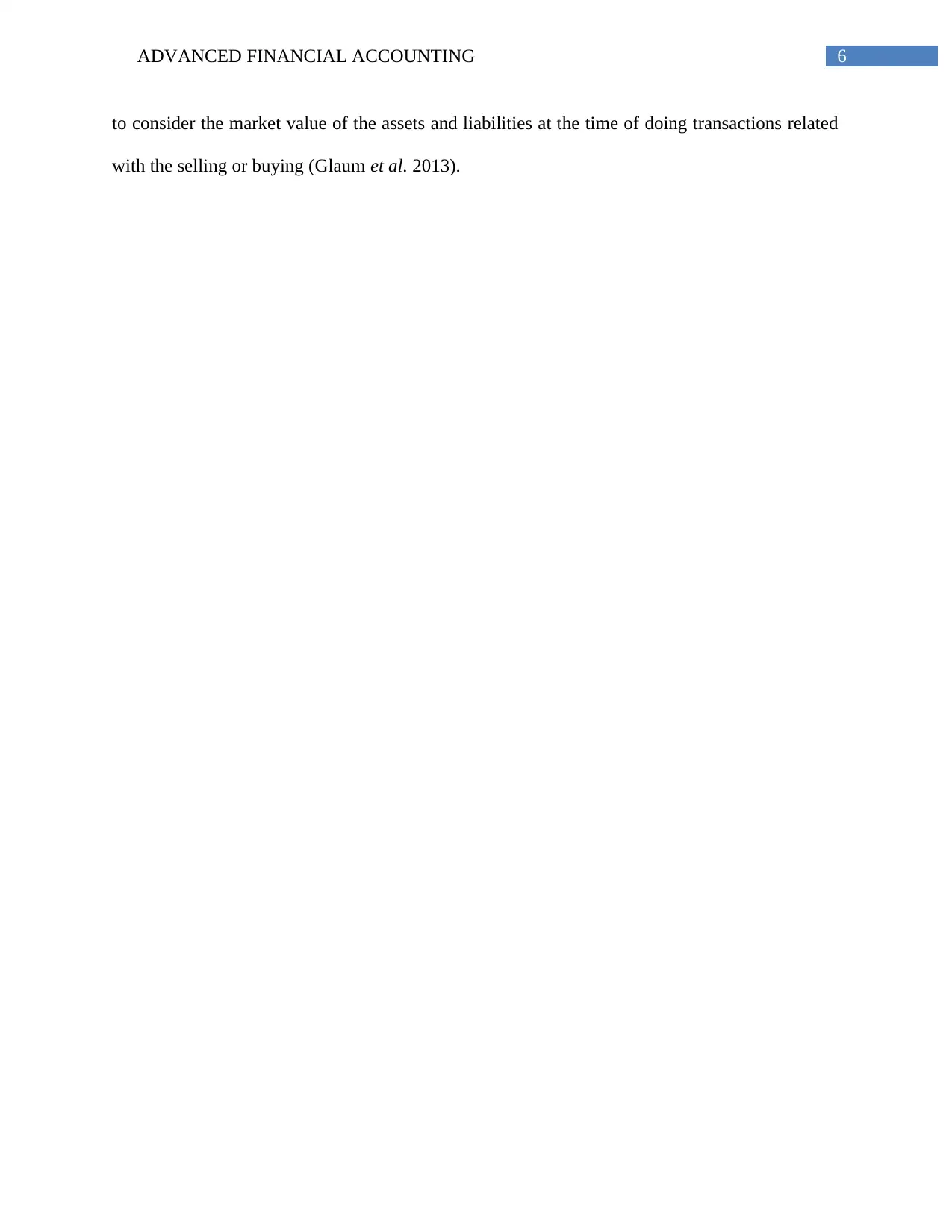
6ADVANCED FINANCIAL ACCOUNTING
to consider the market value of the assets and liabilities at the time of doing transactions related
with the selling or buying (Glaum et al. 2013).
to consider the market value of the assets and liabilities at the time of doing transactions related
with the selling or buying (Glaum et al. 2013).
Paraphrase This Document
Need a fresh take? Get an instant paraphrase of this document with our AI Paraphraser
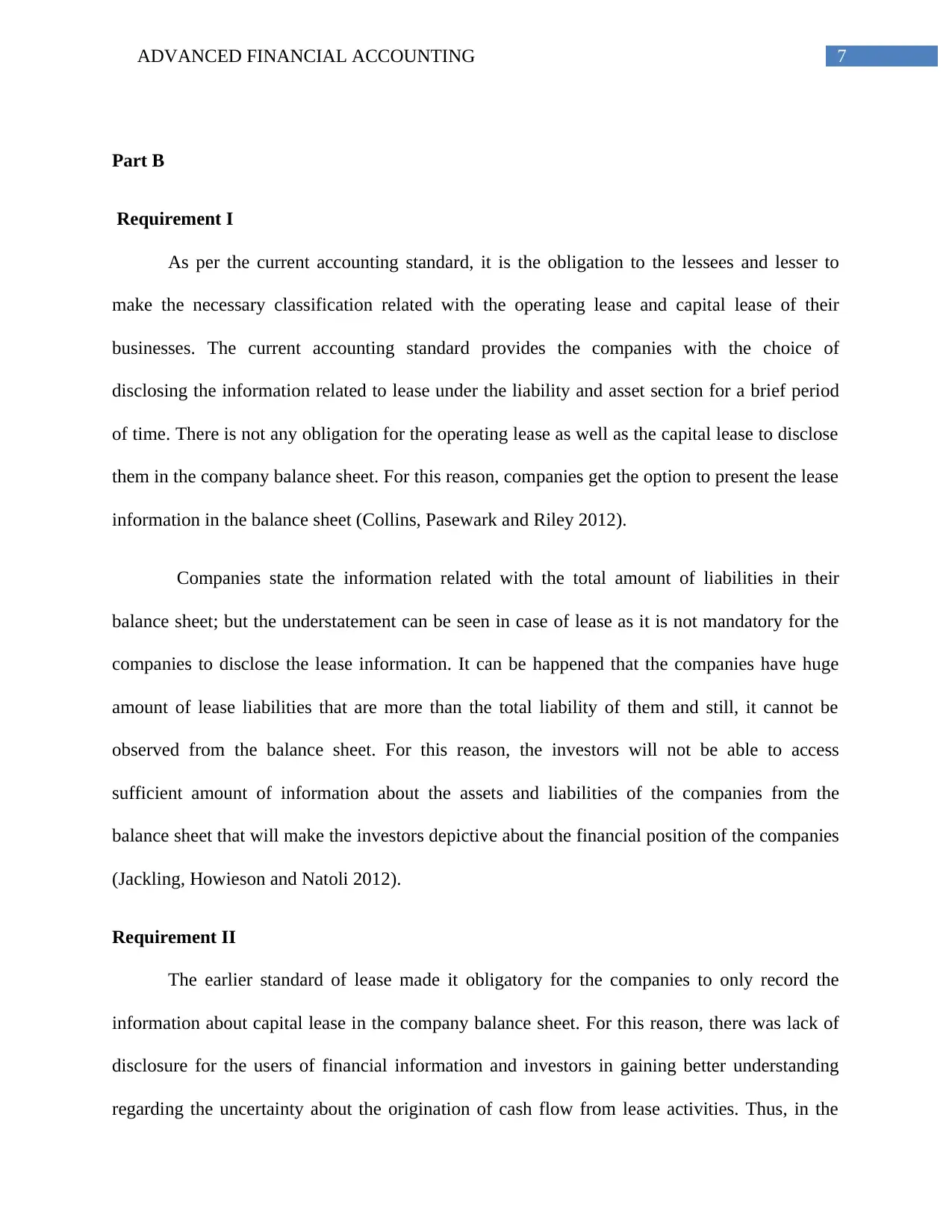
7ADVANCED FINANCIAL ACCOUNTING
Part B
Requirement I
As per the current accounting standard, it is the obligation to the lessees and lesser to
make the necessary classification related with the operating lease and capital lease of their
businesses. The current accounting standard provides the companies with the choice of
disclosing the information related to lease under the liability and asset section for a brief period
of time. There is not any obligation for the operating lease as well as the capital lease to disclose
them in the company balance sheet. For this reason, companies get the option to present the lease
information in the balance sheet (Collins, Pasewark and Riley 2012).
Companies state the information related with the total amount of liabilities in their
balance sheet; but the understatement can be seen in case of lease as it is not mandatory for the
companies to disclose the lease information. It can be happened that the companies have huge
amount of lease liabilities that are more than the total liability of them and still, it cannot be
observed from the balance sheet. For this reason, the investors will not be able to access
sufficient amount of information about the assets and liabilities of the companies from the
balance sheet that will make the investors depictive about the financial position of the companies
(Jackling, Howieson and Natoli 2012).
Requirement II
The earlier standard of lease made it obligatory for the companies to only record the
information about capital lease in the company balance sheet. For this reason, there was lack of
disclosure for the users of financial information and investors in gaining better understanding
regarding the uncertainty about the origination of cash flow from lease activities. Thus, in the
Part B
Requirement I
As per the current accounting standard, it is the obligation to the lessees and lesser to
make the necessary classification related with the operating lease and capital lease of their
businesses. The current accounting standard provides the companies with the choice of
disclosing the information related to lease under the liability and asset section for a brief period
of time. There is not any obligation for the operating lease as well as the capital lease to disclose
them in the company balance sheet. For this reason, companies get the option to present the lease
information in the balance sheet (Collins, Pasewark and Riley 2012).
Companies state the information related with the total amount of liabilities in their
balance sheet; but the understatement can be seen in case of lease as it is not mandatory for the
companies to disclose the lease information. It can be happened that the companies have huge
amount of lease liabilities that are more than the total liability of them and still, it cannot be
observed from the balance sheet. For this reason, the investors will not be able to access
sufficient amount of information about the assets and liabilities of the companies from the
balance sheet that will make the investors depictive about the financial position of the companies
(Jackling, Howieson and Natoli 2012).
Requirement II
The earlier standard of lease made it obligatory for the companies to only record the
information about capital lease in the company balance sheet. For this reason, there was lack of
disclosure for the users of financial information and investors in gaining better understanding
regarding the uncertainty about the origination of cash flow from lease activities. Thus, in the
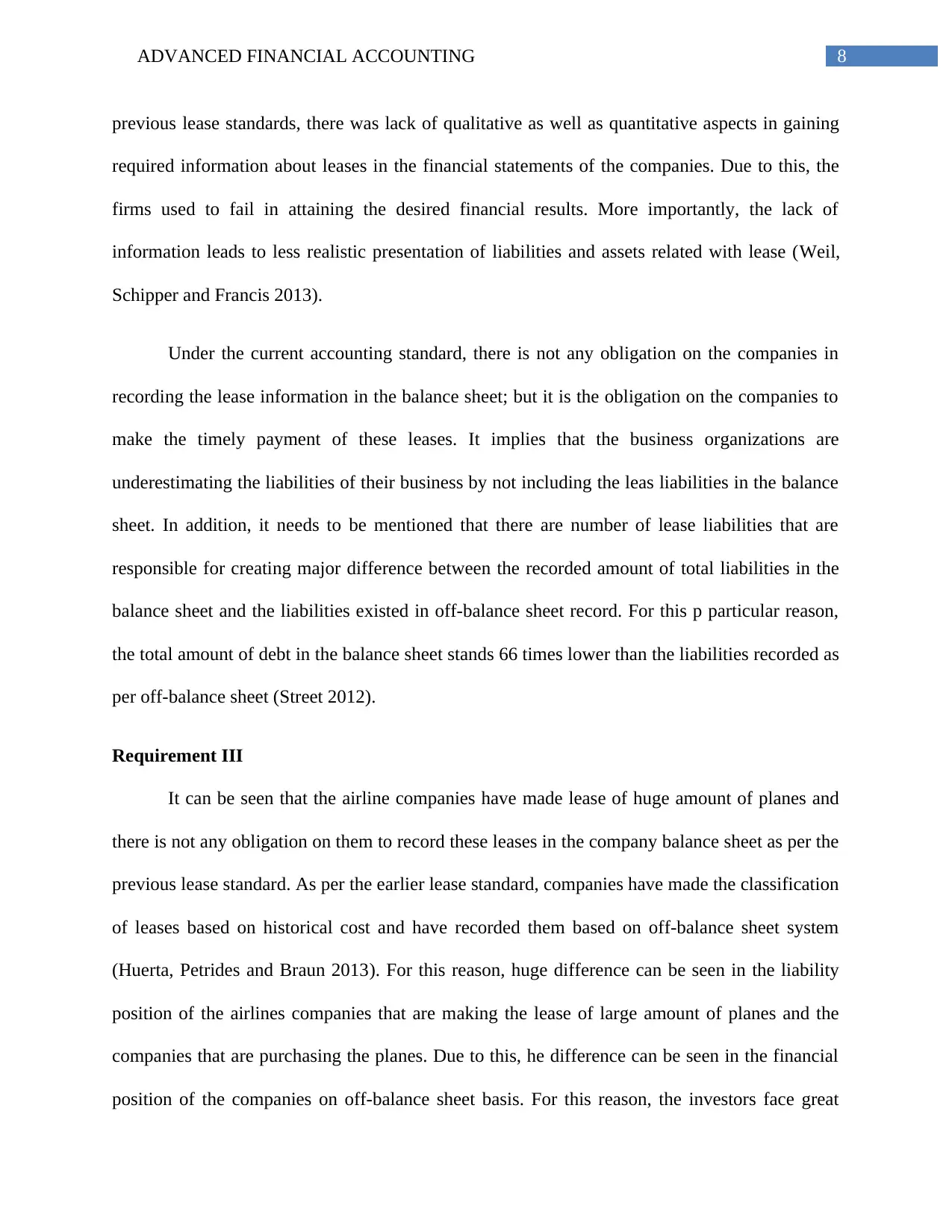
8ADVANCED FINANCIAL ACCOUNTING
previous lease standards, there was lack of qualitative as well as quantitative aspects in gaining
required information about leases in the financial statements of the companies. Due to this, the
firms used to fail in attaining the desired financial results. More importantly, the lack of
information leads to less realistic presentation of liabilities and assets related with lease (Weil,
Schipper and Francis 2013).
Under the current accounting standard, there is not any obligation on the companies in
recording the lease information in the balance sheet; but it is the obligation on the companies to
make the timely payment of these leases. It implies that the business organizations are
underestimating the liabilities of their business by not including the leas liabilities in the balance
sheet. In addition, it needs to be mentioned that there are number of lease liabilities that are
responsible for creating major difference between the recorded amount of total liabilities in the
balance sheet and the liabilities existed in off-balance sheet record. For this p particular reason,
the total amount of debt in the balance sheet stands 66 times lower than the liabilities recorded as
per off-balance sheet (Street 2012).
Requirement III
It can be seen that the airline companies have made lease of huge amount of planes and
there is not any obligation on them to record these leases in the company balance sheet as per the
previous lease standard. As per the earlier lease standard, companies have made the classification
of leases based on historical cost and have recorded them based on off-balance sheet system
(Huerta, Petrides and Braun 2013). For this reason, huge difference can be seen in the liability
position of the airlines companies that are making the lease of large amount of planes and the
companies that are purchasing the planes. Due to this, he difference can be seen in the financial
position of the companies on off-balance sheet basis. For this reason, the investors face great
previous lease standards, there was lack of qualitative as well as quantitative aspects in gaining
required information about leases in the financial statements of the companies. Due to this, the
firms used to fail in attaining the desired financial results. More importantly, the lack of
information leads to less realistic presentation of liabilities and assets related with lease (Weil,
Schipper and Francis 2013).
Under the current accounting standard, there is not any obligation on the companies in
recording the lease information in the balance sheet; but it is the obligation on the companies to
make the timely payment of these leases. It implies that the business organizations are
underestimating the liabilities of their business by not including the leas liabilities in the balance
sheet. In addition, it needs to be mentioned that there are number of lease liabilities that are
responsible for creating major difference between the recorded amount of total liabilities in the
balance sheet and the liabilities existed in off-balance sheet record. For this p particular reason,
the total amount of debt in the balance sheet stands 66 times lower than the liabilities recorded as
per off-balance sheet (Street 2012).
Requirement III
It can be seen that the airline companies have made lease of huge amount of planes and
there is not any obligation on them to record these leases in the company balance sheet as per the
previous lease standard. As per the earlier lease standard, companies have made the classification
of leases based on historical cost and have recorded them based on off-balance sheet system
(Huerta, Petrides and Braun 2013). For this reason, huge difference can be seen in the liability
position of the airlines companies that are making the lease of large amount of planes and the
companies that are purchasing the planes. Due to this, he difference can be seen in the financial
position of the companies on off-balance sheet basis. For this reason, the investors face great
⊘ This is a preview!⊘
Do you want full access?
Subscribe today to unlock all pages.

Trusted by 1+ million students worldwide
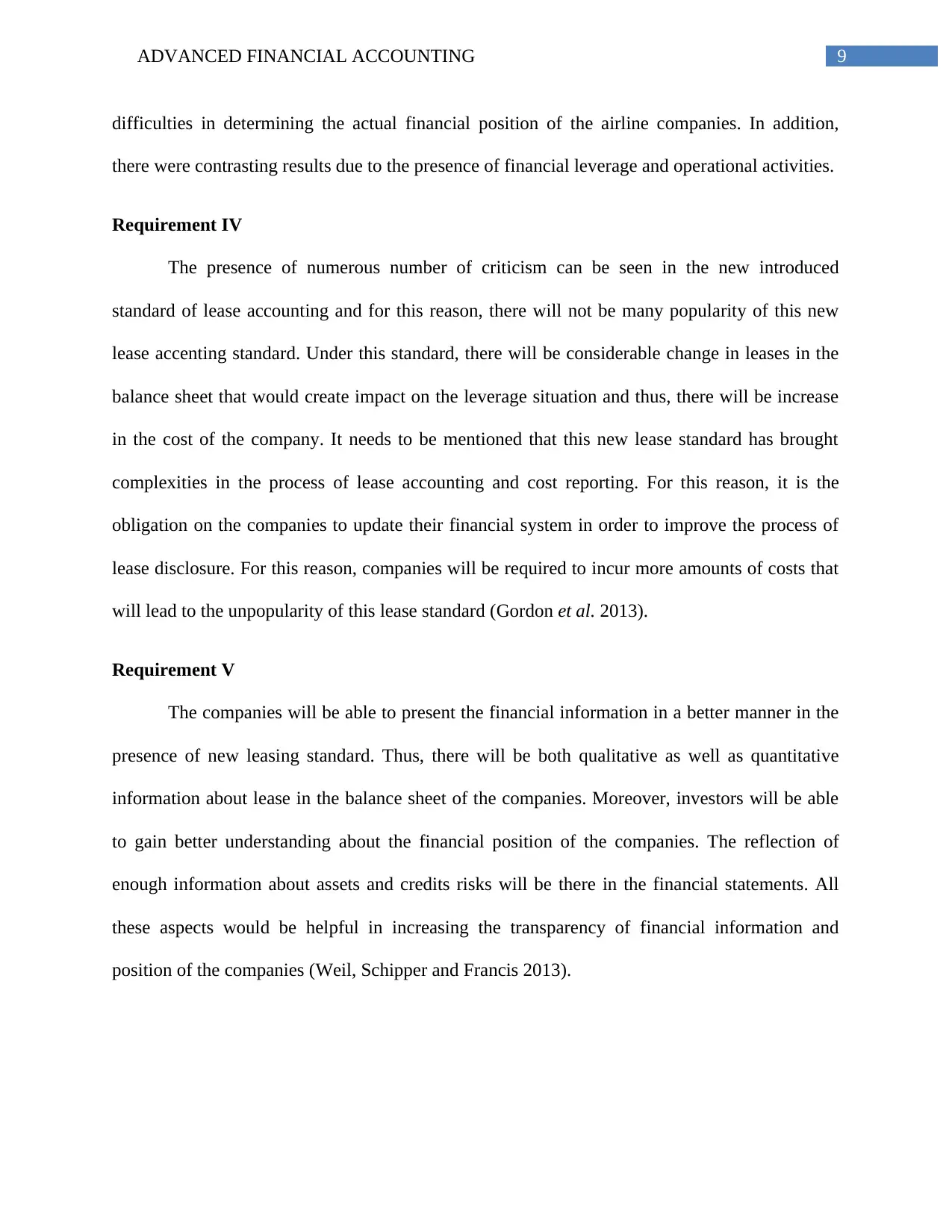
9ADVANCED FINANCIAL ACCOUNTING
difficulties in determining the actual financial position of the airline companies. In addition,
there were contrasting results due to the presence of financial leverage and operational activities.
Requirement IV
The presence of numerous number of criticism can be seen in the new introduced
standard of lease accounting and for this reason, there will not be many popularity of this new
lease accenting standard. Under this standard, there will be considerable change in leases in the
balance sheet that would create impact on the leverage situation and thus, there will be increase
in the cost of the company. It needs to be mentioned that this new lease standard has brought
complexities in the process of lease accounting and cost reporting. For this reason, it is the
obligation on the companies to update their financial system in order to improve the process of
lease disclosure. For this reason, companies will be required to incur more amounts of costs that
will lead to the unpopularity of this lease standard (Gordon et al. 2013).
Requirement V
The companies will be able to present the financial information in a better manner in the
presence of new leasing standard. Thus, there will be both qualitative as well as quantitative
information about lease in the balance sheet of the companies. Moreover, investors will be able
to gain better understanding about the financial position of the companies. The reflection of
enough information about assets and credits risks will be there in the financial statements. All
these aspects would be helpful in increasing the transparency of financial information and
position of the companies (Weil, Schipper and Francis 2013).
difficulties in determining the actual financial position of the airline companies. In addition,
there were contrasting results due to the presence of financial leverage and operational activities.
Requirement IV
The presence of numerous number of criticism can be seen in the new introduced
standard of lease accounting and for this reason, there will not be many popularity of this new
lease accenting standard. Under this standard, there will be considerable change in leases in the
balance sheet that would create impact on the leverage situation and thus, there will be increase
in the cost of the company. It needs to be mentioned that this new lease standard has brought
complexities in the process of lease accounting and cost reporting. For this reason, it is the
obligation on the companies to update their financial system in order to improve the process of
lease disclosure. For this reason, companies will be required to incur more amounts of costs that
will lead to the unpopularity of this lease standard (Gordon et al. 2013).
Requirement V
The companies will be able to present the financial information in a better manner in the
presence of new leasing standard. Thus, there will be both qualitative as well as quantitative
information about lease in the balance sheet of the companies. Moreover, investors will be able
to gain better understanding about the financial position of the companies. The reflection of
enough information about assets and credits risks will be there in the financial statements. All
these aspects would be helpful in increasing the transparency of financial information and
position of the companies (Weil, Schipper and Francis 2013).
Paraphrase This Document
Need a fresh take? Get an instant paraphrase of this document with our AI Paraphraser
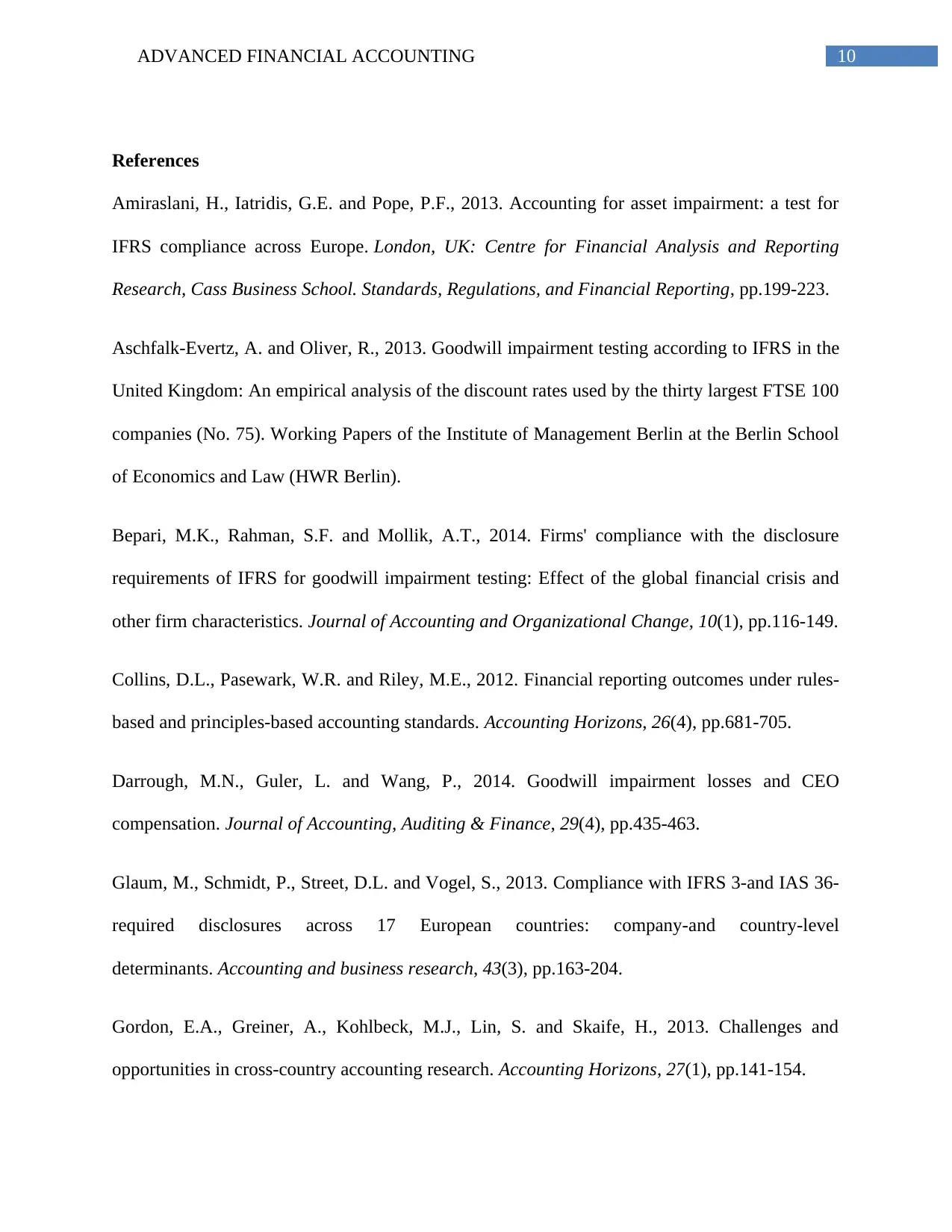
10ADVANCED FINANCIAL ACCOUNTING
References
Amiraslani, H., Iatridis, G.E. and Pope, P.F., 2013. Accounting for asset impairment: a test for
IFRS compliance across Europe. London, UK: Centre for Financial Analysis and Reporting
Research, Cass Business School. Standards, Regulations, and Financial Reporting, pp.199-223.
Aschfalk-Evertz, A. and Oliver, R., 2013. Goodwill impairment testing according to IFRS in the
United Kingdom: An empirical analysis of the discount rates used by the thirty largest FTSE 100
companies (No. 75). Working Papers of the Institute of Management Berlin at the Berlin School
of Economics and Law (HWR Berlin).
Bepari, M.K., Rahman, S.F. and Mollik, A.T., 2014. Firms' compliance with the disclosure
requirements of IFRS for goodwill impairment testing: Effect of the global financial crisis and
other firm characteristics. Journal of Accounting and Organizational Change, 10(1), pp.116-149.
Collins, D.L., Pasewark, W.R. and Riley, M.E., 2012. Financial reporting outcomes under rules-
based and principles-based accounting standards. Accounting Horizons, 26(4), pp.681-705.
Darrough, M.N., Guler, L. and Wang, P., 2014. Goodwill impairment losses and CEO
compensation. Journal of Accounting, Auditing & Finance, 29(4), pp.435-463.
Glaum, M., Schmidt, P., Street, D.L. and Vogel, S., 2013. Compliance with IFRS 3-and IAS 36-
required disclosures across 17 European countries: company-and country-level
determinants. Accounting and business research, 43(3), pp.163-204.
Gordon, E.A., Greiner, A., Kohlbeck, M.J., Lin, S. and Skaife, H., 2013. Challenges and
opportunities in cross-country accounting research. Accounting Horizons, 27(1), pp.141-154.
References
Amiraslani, H., Iatridis, G.E. and Pope, P.F., 2013. Accounting for asset impairment: a test for
IFRS compliance across Europe. London, UK: Centre for Financial Analysis and Reporting
Research, Cass Business School. Standards, Regulations, and Financial Reporting, pp.199-223.
Aschfalk-Evertz, A. and Oliver, R., 2013. Goodwill impairment testing according to IFRS in the
United Kingdom: An empirical analysis of the discount rates used by the thirty largest FTSE 100
companies (No. 75). Working Papers of the Institute of Management Berlin at the Berlin School
of Economics and Law (HWR Berlin).
Bepari, M.K., Rahman, S.F. and Mollik, A.T., 2014. Firms' compliance with the disclosure
requirements of IFRS for goodwill impairment testing: Effect of the global financial crisis and
other firm characteristics. Journal of Accounting and Organizational Change, 10(1), pp.116-149.
Collins, D.L., Pasewark, W.R. and Riley, M.E., 2012. Financial reporting outcomes under rules-
based and principles-based accounting standards. Accounting Horizons, 26(4), pp.681-705.
Darrough, M.N., Guler, L. and Wang, P., 2014. Goodwill impairment losses and CEO
compensation. Journal of Accounting, Auditing & Finance, 29(4), pp.435-463.
Glaum, M., Schmidt, P., Street, D.L. and Vogel, S., 2013. Compliance with IFRS 3-and IAS 36-
required disclosures across 17 European countries: company-and country-level
determinants. Accounting and business research, 43(3), pp.163-204.
Gordon, E.A., Greiner, A., Kohlbeck, M.J., Lin, S. and Skaife, H., 2013. Challenges and
opportunities in cross-country accounting research. Accounting Horizons, 27(1), pp.141-154.
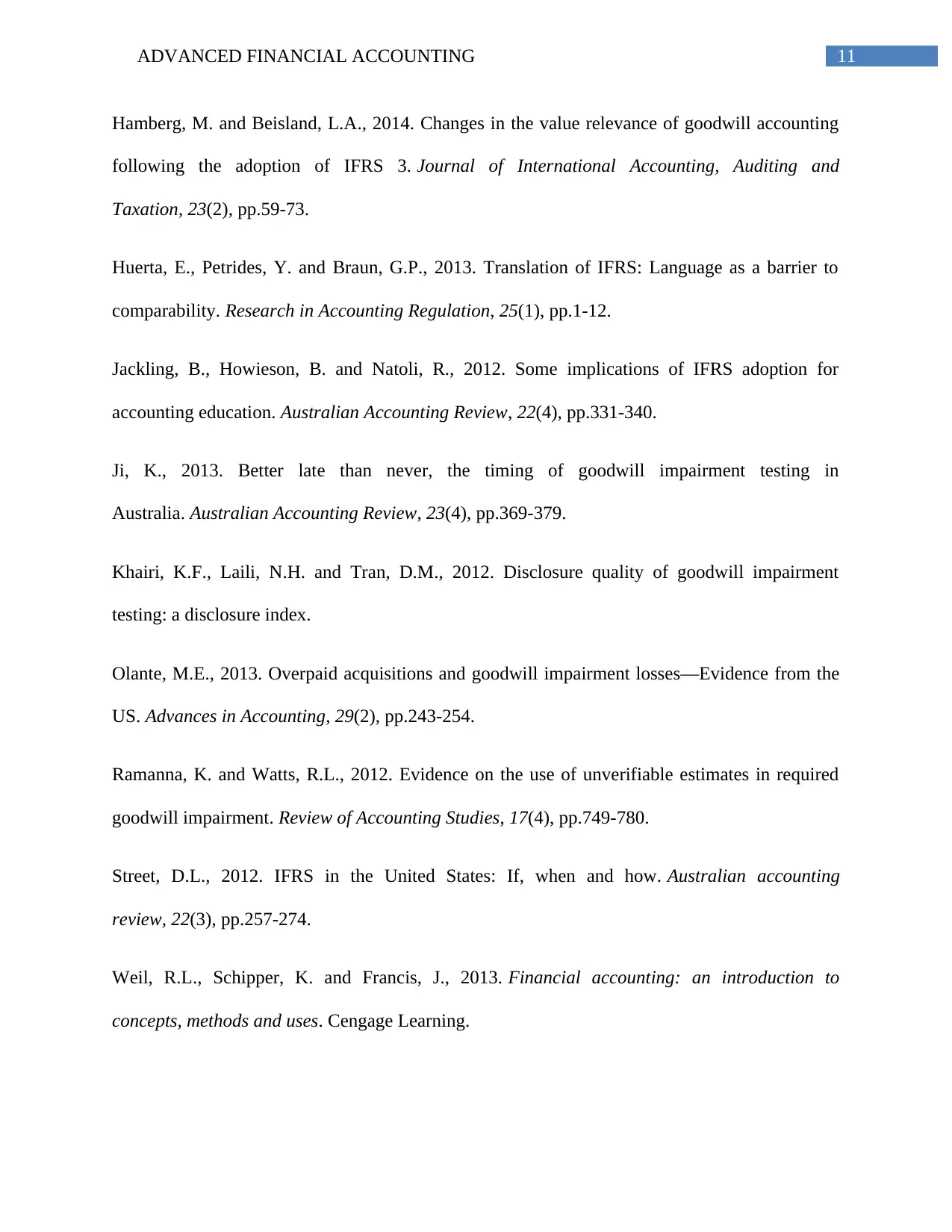
11ADVANCED FINANCIAL ACCOUNTING
Hamberg, M. and Beisland, L.A., 2014. Changes in the value relevance of goodwill accounting
following the adoption of IFRS 3. Journal of International Accounting, Auditing and
Taxation, 23(2), pp.59-73.
Huerta, E., Petrides, Y. and Braun, G.P., 2013. Translation of IFRS: Language as a barrier to
comparability. Research in Accounting Regulation, 25(1), pp.1-12.
Jackling, B., Howieson, B. and Natoli, R., 2012. Some implications of IFRS adoption for
accounting education. Australian Accounting Review, 22(4), pp.331-340.
Ji, K., 2013. Better late than never, the timing of goodwill impairment testing in
Australia. Australian Accounting Review, 23(4), pp.369-379.
Khairi, K.F., Laili, N.H. and Tran, D.M., 2012. Disclosure quality of goodwill impairment
testing: a disclosure index.
Olante, M.E., 2013. Overpaid acquisitions and goodwill impairment losses—Evidence from the
US. Advances in Accounting, 29(2), pp.243-254.
Ramanna, K. and Watts, R.L., 2012. Evidence on the use of unverifiable estimates in required
goodwill impairment. Review of Accounting Studies, 17(4), pp.749-780.
Street, D.L., 2012. IFRS in the United States: If, when and how. Australian accounting
review, 22(3), pp.257-274.
Weil, R.L., Schipper, K. and Francis, J., 2013. Financial accounting: an introduction to
concepts, methods and uses. Cengage Learning.
Hamberg, M. and Beisland, L.A., 2014. Changes in the value relevance of goodwill accounting
following the adoption of IFRS 3. Journal of International Accounting, Auditing and
Taxation, 23(2), pp.59-73.
Huerta, E., Petrides, Y. and Braun, G.P., 2013. Translation of IFRS: Language as a barrier to
comparability. Research in Accounting Regulation, 25(1), pp.1-12.
Jackling, B., Howieson, B. and Natoli, R., 2012. Some implications of IFRS adoption for
accounting education. Australian Accounting Review, 22(4), pp.331-340.
Ji, K., 2013. Better late than never, the timing of goodwill impairment testing in
Australia. Australian Accounting Review, 23(4), pp.369-379.
Khairi, K.F., Laili, N.H. and Tran, D.M., 2012. Disclosure quality of goodwill impairment
testing: a disclosure index.
Olante, M.E., 2013. Overpaid acquisitions and goodwill impairment losses—Evidence from the
US. Advances in Accounting, 29(2), pp.243-254.
Ramanna, K. and Watts, R.L., 2012. Evidence on the use of unverifiable estimates in required
goodwill impairment. Review of Accounting Studies, 17(4), pp.749-780.
Street, D.L., 2012. IFRS in the United States: If, when and how. Australian accounting
review, 22(3), pp.257-274.
Weil, R.L., Schipper, K. and Francis, J., 2013. Financial accounting: an introduction to
concepts, methods and uses. Cengage Learning.
⊘ This is a preview!⊘
Do you want full access?
Subscribe today to unlock all pages.

Trusted by 1+ million students worldwide
1 out of 14
Related Documents
Your All-in-One AI-Powered Toolkit for Academic Success.
+13062052269
info@desklib.com
Available 24*7 on WhatsApp / Email
![[object Object]](/_next/static/media/star-bottom.7253800d.svg)
Unlock your academic potential
Copyright © 2020–2025 A2Z Services. All Rights Reserved. Developed and managed by ZUCOL.





